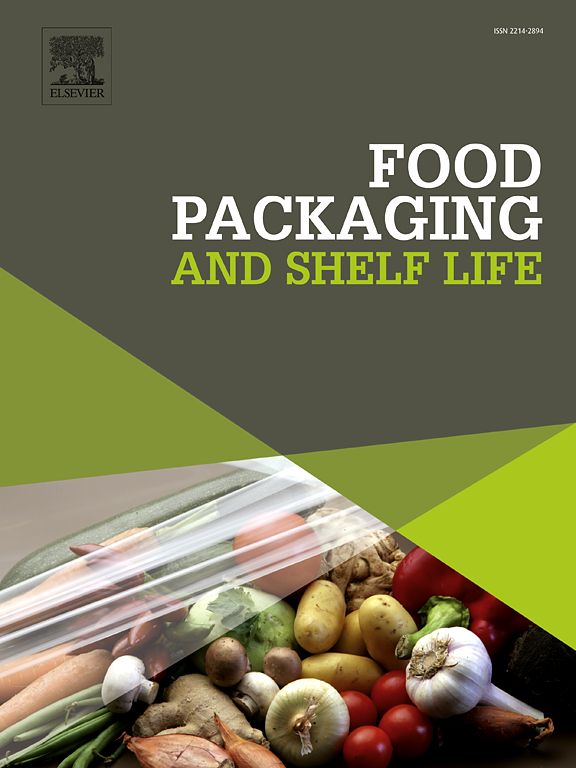Facile and green synthesis of multifunctional nitrogen-doped carbon quantum dots from Ginkgo biloba leaves for antibacterial, antioxidant, and bioactive coating applications
IF 10.6
1区 农林科学
Q1 FOOD SCIENCE & TECHNOLOGY
引用次数: 0
Abstract
As the demand for sustainable and functional food packaging increases, carbon quantum dots (CQDs) have demonstrated immense potential for incorporation into biopolymer-based active packaging and coatings. We report a green and sustainable hydrothermal approach for the synthesis of surface-passivated nitrogen-doped carbon quantum dots (N-CQDs) using Ginkgo biloba leaves as a renewable carbon precursor. Polyethylene glycol (PEG) acted as a passivating agent, yielding N-CQDs with strong cyan fluorescence, excitation-dependent emission, and high aqueous solubility. The synthesized N-CQDs exhibited remarkable monodispersity (2.4 ± 0.72 nm), a surface charge of −15.1 mV, and a fluorescence quantum yield of 9.69 %. The radical scavenging efficiency of N-CQDs was notably improved, achieving 72.26 % for DPPH and 96.97 % for ABTS, indicating their strong antioxidant functionality. Inhibition zones of 16 mm against E. coli and 18 mm against S. aureus confirmed their antimicrobial efficacy. Cytotoxicity tests confirmed that the prepared N-CQDs were non-toxic to L929 cells even at a higher concentration of 500 μg/mL. N-CQDs incorporated within CMC-based coatings displayed significant antioxidant and antimicrobial properties, successfully inhibiting fungal growth and prolonging mandarin storage life over 15 days. These findings highlight the potential of N-CQDs as sustainable, biocompatible, and versatile nanomaterials, offering improved functionality in active food packaging applications.
银杏叶中多功能氮掺杂碳量子点的简单绿色合成,用于抗菌、抗氧化和生物活性涂层
随着对可持续和功能性食品包装需求的增加,碳量子点(CQDs)在生物聚合物活性包装和涂料中已经显示出巨大的潜力。我们报道了一种绿色可持续的水热方法,用于合成表面钝化氮掺杂碳量子点(N-CQDs),使用银杏叶作为可再生碳前驱体。聚乙二醇(PEG)作为钝化剂,生成的N-CQDs具有强烈的青色荧光、激发依赖性发射和高水溶性。合成的N-CQDs具有显著的单分散性(2.4 ± 0.72 nm),表面电荷为−15.1 mV,荧光量子产率为9.69 %。N-CQDs对DPPH和ABTS的自由基清除效率分别达到72.26 %和96.97 %,具有较强的抗氧化功能。对大肠杆菌的抑制区为16 mm,对金黄色葡萄球菌的抑制区为18 mm。细胞毒性实验证实,制备的N-CQDs在500 μg/mL的浓度下对L929细胞无毒。在cmc涂层中加入的N-CQDs显示出显著的抗氧化和抗菌性能,成功地抑制了真菌的生长,延长了柑橘的储存寿命超过15天。这些发现突出了N-CQDs作为可持续、生物相容性和多用途纳米材料的潜力,在活性食品包装应用中提供了改进的功能。
本文章由计算机程序翻译,如有差异,请以英文原文为准。
求助全文
约1分钟内获得全文
求助全文
来源期刊

Food Packaging and Shelf Life
Agricultural and Biological Sciences-Food Science
CiteScore
14.00
自引率
8.80%
发文量
214
审稿时长
70 days
期刊介绍:
Food packaging is crucial for preserving food integrity throughout the distribution chain. It safeguards against contamination by physical, chemical, and biological agents, ensuring the safety and quality of processed foods. The evolution of novel food packaging, including modified atmosphere and active packaging, has extended shelf life, enhancing convenience for consumers. Shelf life, the duration a perishable item remains suitable for sale, use, or consumption, is intricately linked with food packaging, emphasizing its role in maintaining product quality and safety.
 求助内容:
求助内容: 应助结果提醒方式:
应助结果提醒方式:


